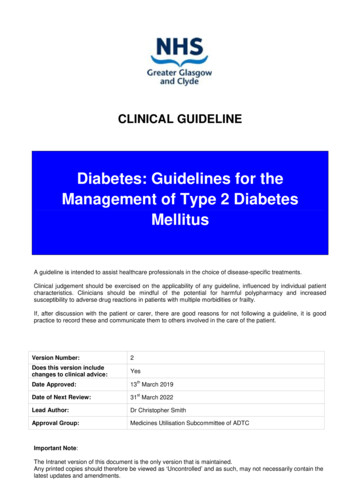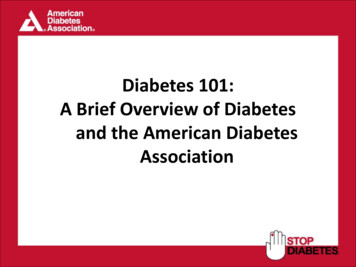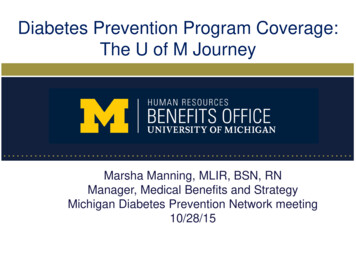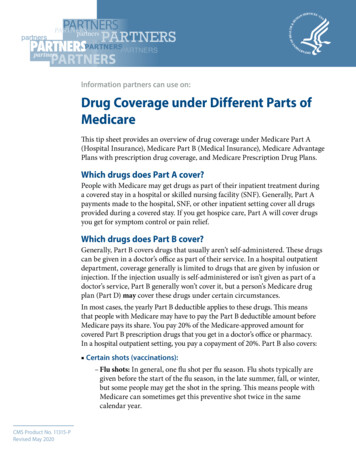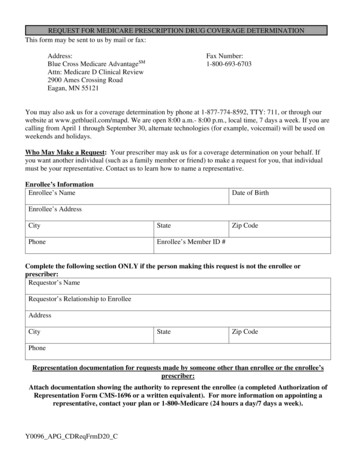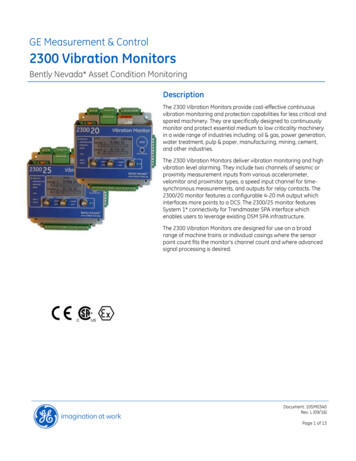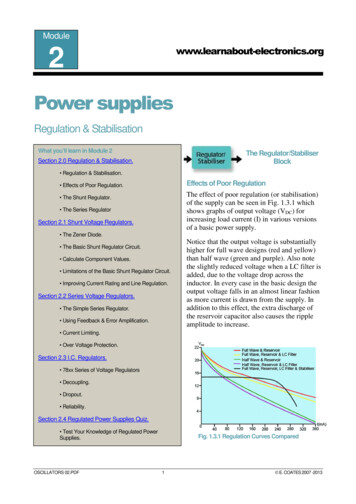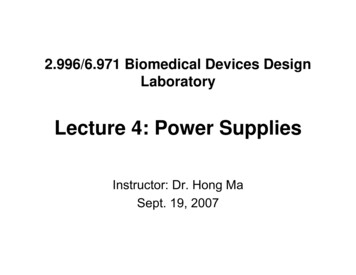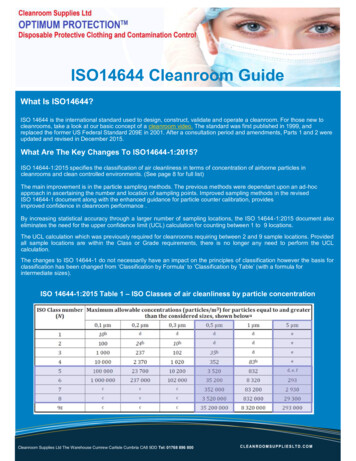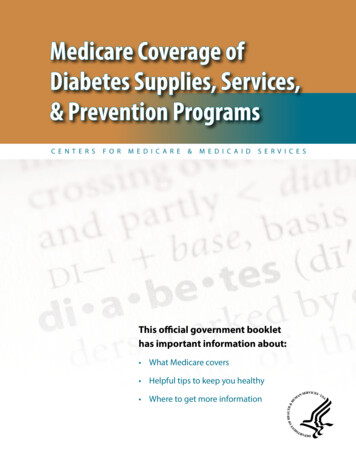
Transcription
Medicare Coverage ofDiabetes Supplies, Services,& Prevention ProgramsC E NT E R SF O RM E D I C A R E&M E D I C A I DS E RV I C E SThis official government booklethas important information about: What Medicare covers Helpful tips to keep you healthy Where to get more information
The information in this booklet describes the Medicare Program at the time thisbooklet was printed. Changes may occur after printing. Visit Medicare.gov, or call1-800-MEDICARE (1-800-633-4227) to get the most current information.TTY users can call 1-877-486-2048.“Medicare Coverage of Diabetes Supplies, Services, & Prevention Programs” isn’ta legal document. Official Medicare Program legal guidance is contained in therelevant statutes, regulations, and rulings.This educational publication was produced and disseminated at U.S. taxpayerexpense. It’s not a guidance document.
3Table of ContentsIntroduction . . . . . . . . . . . . . . . . . . . . . . . . . . . . . . . . . . . . . . 4Section 1: Medicare Coverage for Diabetes At-a-Glance . . . . . . . . . . . . . . . . . 5Section 2: Medicare Part B-Coverage for Diabetes Supplies . . . . . . . . . . . . . . 9Blood sugar self-testing equipment & supplies . . . . . . . . . . . . . . . . . . . . . . . . . . 10Insulin pumps . . . . . . . . . . . . . . . . . . . . . . . . . . . . . . . . . . . . . . . . . . . . . . . . . . . . . 13Therapeutic shoes or inserts . . . . . . . . . . . . . . . . . . . . . . . . . . . . . . . . . . . . . . . . . 13Replacing lost or damaged durable medical equipment or supplies in adisaster or emergency . . . . . . . . . . . . . . . . . . . . . . . . . . . . . . . . . . . . . . . . . . . . . 14Section 3: Medicare Drug Coverage for Diabetes . . . . . . . . . . . . . . . . . . . . . 15Insulin . . . . . . . . . . . . . . . . . . . . . . . . . . . . . . . . . . . . . . . . . . . . . . . . . . . . . . . . . . 16Anti-diabetic drugs . . . . . . . . . . . . . . . . . . . . . . . . . . . . . . . . . . . . . . . . . . . . . . . . 16Diabetes supplies . . . . . . . . . . . . . . . . . . . . . . . . . . . . . . . . . . . . . . . . . . . . . . . . . . 16For more information . . . . . . . . . . . . . . . . . . . . . . . . . . . . . . . . . . . . . . . . . . . . . . 16Section 4: Medicare Coverage for Diabetes Screenings & Services . . . . . . . . . 17Diabetes screenings . . . . . . . . . . . . . . . . . . . . . . . . . . . . . . . . . . . . . . . . . . . . . . . . 18Medicare Diabetes Prevention Program . . . . . . . . . . . . . . . . . . . . . . . . . . . . . . . 18Diabetes self-management training . . . . . . . . . . . . . . . . . . . . . . . . . . . . . . . . . . . 19Medical nutrition therapy services . . . . . . . . . . . . . . . . . . . . . . . . . . . . . . . . . . . . 22Foot exams & treatment . . . . . . . . . . . . . . . . . . . . . . . . . . . . . . . . . . . . . . . . . . . . 23Hemoglobin A1c tests . . . . . . . . . . . . . . . . . . . . . . . . . . . . . . . . . . . . . . . . . . . . . . 23Glaucoma tests . . . . . . . . . . . . . . . . . . . . . . . . . . . . . . . . . . . . . . . . . . . . . . . . . . . . 23Flu & pneumococcal shots . . . . . . . . . . . . . . . . . . . . . . . . . . . . . . . . . . . . . . . . . . . 24“Welcome to Medicare” preventive visit . . . . . . . . . . . . . . . . . . . . . . . . . . . . . . . 24Yearly “Wellness” visit . . . . . . . . . . . . . . . . . . . . . . . . . . . . . . . . . . . . . . . . . . . . . . 24Supplies & services that Medicare doesn’t cover . . . . . . . . . . . . . . . . . . . . . . . . 24Section 5: Helpful Tips & Resources . . . . . . . . . . . . . . . . . . . . . . . . . . . . . 25Tips to help control diabetes . . . . . . . . . . . . . . . . . . . . . . . . . . . . . . . . . . . . . . . . 26Phone numbers & websites . . . . . . . . . . . . . . . . . . . . . . . . . . . . . . . . . . . . . . . . . 27
4IntroductionThis booklet explains Medicare coverage of diabetes supplies and services inOriginal Medicare and with Medicare drug coverage (Part D).Original Medicare is fee-for-service coverage. The government usually pays yourhealth care providers directly for your Medicare Part A (Hospital Insurance)and/or Medicare Part B (Medical Insurance) benefits.If you have other insurance that supplements Original Medicare, like a MedicareSupplement Insurance (Medigap) policy, it may pay some of the costs for some ofthe services described in this booklet. Contact your plan’s benefits administratorfor more information.If you have a Medicare Advantage Plan or other Medicare health plan, your planmust give you at least the same coverage as Original Medicare, but it may havedifferent rules. Your costs, rights, protections, and choices for where you get yourcare might be different if you’re in one of these plans. You might also get extrabenefits. Read your plan materials, or call your benefits administrator for moreinformation.It will be helpful to understand these terms as you read thisbooklet:Coinsurance: An amount you may be required to pay as your share of the costfor services after you pay any deductibles. Coinsurance is usually a percentage (forexample, 20%).Copayment: An amount you may be required to pay as your share of the costfor a medical service or supply, like a doctor’s visit, hospital outpatient visit, orprescription drug. A copayment is usually a set amount, rather than a percentage.For example, you might pay 10 or 20 for a doctor’s visit or prescription.Deductible: The amount you must pay for health care or prescriptions beforeOriginal Medicare, your prescription drug plan, or your other insurance begins topay.Durable medical equipment: Certain medical equipment, like a walker,wheelchair, or hospital bed, that’s ordered by your doctor for use in the home.Medicare-approved amount: In Original Medicare, this is the amount a doctoror supplier that accepts assignment can be paid. Assignment is an agreement byyour doctor, provider, or supplier to be paid directly by Medicare, to accept thepayment amount Medicare approves for the service, and not to bill you for anymore than the Medicare deductible and coinsurance. It may be less than the actualamount a doctor or supplier charges. Medicare pays part of this amount and you’reresponsible for the difference.
51SECTIONMedicare Coverage forDiabetes At-a-GlanceThe chart on pages 6–8 provides a quick overviewof some of the diabetes services and suppliescovered by Medicare Part B (Medical Insurance) andMedicare drug coverage (Part D).Generally, Part B covers the services that may affectpeople who have diabetes. Part B also covers somepreventive services for people who are at risk fordiabetes. You must have Part B to get services andsupplies it covers.Part D covers diabetes supplies used to inject or inhaleinsulin. You must be enrolled in a Medicare drug planto get supplies Part D covers.
6Section 1: Medicare Coverage for Diabetes At-a-GlanceSupply/serviceWhat Medicare coversWhat you payAnti-diabeticdrugsSee page 16.Part D covers anti-diabetic drugs to maintain bloodsugar (glucose).Coinsurance or copaymentDiabetesscreening testsSee page 18.Part B covers these screenings if your doctordetermines you’re at risk for diabetes. You may be eligible for up to 2 diabetes screening tests each year.No coinsurance, copayment, orPart B deductible for screeningsMedicareDiabetesPreventionProgramSee pages 18–19.Part B covers a once-per-lifetime health behaviorchange program to help you prevent diabetes.Nothing for these services ifyou’re eligibleDiabetes selfmanagementtrainingSee pages 19–22.Part B covers diabetes self-management trainingservices for people recently diagnosed with diabetes orat risk for complications from diabetes. For Medicareto cover these services, your doctor or other health careprovider must order it, and an accredited individual orprogram must provide the services.20% of the Medicare-approvedamount after the yearly Part BdeductibleDiabetesequipment &suppliesSee pages 10–13.Part B covers home blood sugar (glucose) monitorsand supplies you use with the equipment, includingblood sugar test strips, lancet devices, and lancets. Theremay be limits on how much or how often you get thesesupplies.20% of the Medicare-approvedamount after the yearly Part BdeductibleDiabetessuppliesSee page 16.Part D covers certain medical supplies to administerCoinsurance or copaymentinsulin (like syringes, needles, alcohol swabs, gauze,and inhaled insulin devices).Part D deductible may also applyGenerally, 20% of theMedicare-approved amount afterthe yearly Part B deductible forthe doctor’s visitPart D deductible may also apply
Section 1: Medicare Coverage for Diabetes At-a-Glance7Supply/serviceWhat Medicare coversWhat you payFlu &pneumococcalshotsSee page 24.Flu shot—To help prevent influenza orflu virus. Part B covers this shot once a fluseason in the fall or winter to help preventinfluenza or flu virus.Pneumococcal shot—Part B coversthis shot to help prevent pneumococcalinfections (like certain types ofpneumonia).No coinsurance, copayment, orPart B deductible if your doctoror health care provider acceptsassignmentFoot exams &treatmentSee page 23.Part B covers a foot exam every 6 monthsif you have diabetic peripheral neuropathyand loss of protective sensation, as long asyou haven’t seen a foot care professionalfor another reason between visits.20% of the Medicare-approvedamount after the yearly Part BdeductibleGlaucoma testsSee page 23.Part B covers this test once every 12months if you’re at high risk for glaucoma.A doctor legally authorized by the statemust do the test.20% of the Medicare-approvedamount after the yearly Part BdeductibleInsulinSee page 16.Part D covers insulin that isn’tadministered with an insulin pump.Coinsurance or copaymentPart D deductible may also apply
8Section 1: Medicare Coverage for Diabetes At-a-GlanceSupply/serviceWhat Medicare coversWhat you payInsulin pumpsSee page 13.Part B covers external durable insulinpumps and the insulin the pump usesunder durable medical equipment if youmeet certain conditions.20% of the Medicare-approvedamount after the yearly Part BdeductibleMedical nutritiontherapy (MNT)servicesSee pages 22–23.Part B may cover medical nutritiontherapy and certain related services ifyou have diabetes or kidney disease. Yourdoctor or other health care provider mustrefer you for these services.No copayment, coinsurance, orPart B deductible if your doctoror health care provider acceptsassignmentTherapeuticshoes or insertsSee pages 13–14.Part B covers therapeutic shoes or insertsif you have diabetes and severe diabeticfoot disease.20% of the Medicare-approvedamount after the yearly Part Bdeductible“Welcome toMedicare”preventive visitSee page 24.Within the first 12 months you havePart B, Medicare covers a one-timereview of your health, and education andcounseling about preventive services,including certain screenings, shots, andreferrals for other care, if needed.No copayment, coinsurance, orPart B deductible if your doctoror health care provider acceptsassignmentYearly “Wellness”visitSee page 24.If you’ve already had Part B for longerthan 12 months, you can get a yearly“Wellness” visit to develop or update apersonalized prevention plan based onyour current health and risk factors.No copayment, coinsurance orPart B deductible if your doctoror health care provider acceptsassignmentIf you had a “Welcome toMedicare” visit, you’ll have to wait12 months before you can get yourfirst yearly “Wellness” visit.
92SECTIONMedicare Part B Coveragefor Diabetes SuppliesThis section provides information about Part B (MedicalInsurance) and its coverage of diabetes supplies.Medicare covers certain supplies if you have diabetes andPart B, including: Blood sugar self-testing equipment & supplies.See pages 10–13. Insulin pumps. See page 13. Therapeutic shoes or inserts. See pages 13–14.
10Section 2: Medicare Part B-covered Diabetes SuppliesBlood sugar self-testing equipment & suppliesPart B covers blood sugar (also called blood glucose) self-testing equipment andsupplies as durable medical equipment, even if you don’t use insulin.Self-testing supplies include: Blood sugar monitors Blood sugar test strips Lancet devices and lancets Glucose control solutions for checking the accuracy of testing equipmentand test stripsPart B covers the same type of blood sugar testing supplies listed above for peoplewith diabetes whether or not they use insulin. However, the amount of suppliesthat Part B covers varies. If you use insulin, you may be able to get up to 300 test strips and 300 lancetsevery 3 months. If you don’t use insulin, you may be able to get 100 test strips and 100 lancetsevery 3 months.If your doctor says it’s medically necessary, and if other qualifications anddocumentation requirements are met, Medicare will allow you to getadditional test strips and lancets. “Medically necessary” means that you needservices or supplies for the diagnosis or treatment of your medical conditionand meet accepted standards of medical practice. You may need to keep arecord that shows how often you’re actually testing yourself.If you meet certain criteria, Medicare also covers therapeutic continuous glucosemonitors and related supplies approved for use in place of blood sugar monitorsfor making diabetes treatment decisions (like changes in diet and insulin dosage).If you use insulin and require frequent adjustments to your insulin regimen/dosage, Medicare may cover a continuous glucose monitor if your doctordetermines that you meet all of the requirements for Medicare coverage, includingthe need to frequently check your blood sugar (4 or more times a day) and theneed to either use an insulin pump or receive 3 or more insulin injections per day.You must also make routine in-person visits with your doctor.If you have questions about diabetes supplies, visit Medicare.gov/coverage.You can also call 1-800-MEDICARE (1-800-633-4227). TTY users can call1-877-486-2048.
Section 2: Medicare Part B-covered Diabetes Supplies11Blood sugar self-testing equipment & supplies (continued)What do I need from my doctor to get these covered supplies?Medicare will only cover your blood sugar self-testing equipment and supplies if youget a prescription from your doctor. The prescription should include: Whether you have diabetes. What kind of blood sugar monitor you need and why you need it. (If you need aspecial monitor because of vision problems, your doctor must explain that.) Whether you use insulin. How often you should test your blood sugar. How many test strips and lancets you need for one month.Where can I get these supplies? You can order and pick up your supplies at your pharmacy. You can order your supplies from a medical equipment supplier. Generally, a“supplier” is any company, person, or agency that gives you a medical item orservice, except when you’re an inpatient in a hospital or skilled nursing facility.If you get your supplies this way, you must place the order yourself. You’ll need aprescription from your doctor to place your order, but your doctor can’t order thesupplies for you.Keep these in mind: You must ask for refills for your supplies. You need a new prescription from your doctor for your lancets and test stripsevery 12 months.What supplier or pharmacy should I use?Before you get a supply it’s important to ask the supplier or pharmacy these questions: Are you enrolled in Medicare? Do you accept assignment?If the answer to either of these 2 questions is “no,” you should call another supplieror pharmacy in your area who answers “yes” to be sure Medicare covers yourpurchase and to save you money.If you can’t find a supplier or pharmacy in your area that’s enrolled in Medicare andaccepts assignment, you may want to order your supplies through the mail. Thismay also save you money.To find a supplier that’s enrolled in Medicare, visit Medicare.gov/supplier. Or, call1-800-MEDICARE (1-800-633-4227). TTY users can call 1-877-486-2048.
12Section 2: Medicare Part B-covered Diabetes SuppliesBlood sugar self-testing equipment & supplies (continued)Note: Medicare won’t pay for any supplies you didn’t ask for, or for anysupplies that were sent to you automatically from suppliers, including bloodsugar monitors, test strips, and lancets. If you’re getting supplies sent to youautomatically, getting advertisements that are misleading, or suspect fraudrelating to your diabetes supplies, call 1-800-MEDICARE (1-800-633-4227). TTYusers can call 1-877-486-2048.You must get supplies from a pharmacy or supplier that’s enrolled in Medicare.If you go to a pharmacy or supplier that isn’t enrolled in Medicare, Medicarewon’t pay. You’ll have to pay the entire bill for any supplies from non-enrolledpharmacies or non-enrolled suppliers.Who’s responsible for submitting claims?All Medicare-enrolled pharmacies and suppliers must submit claims for bloodsugar (glucose) monitors, test strips, and other items covered under durablemedical equipment. You can’t submit a claim for a blood sugar monitor or teststrips yourself.You should also make sure that the pharmacy or supplier accepts assignmentfor Medicare-covered supplies. This could save you money. If the pharmacy orsupplier accepts assignment, Medicare will pay the pharmacy or supplier directly.What do I have to pay?You pay no more than your coinsurance amount when you get your supplies froma pharmacy or supplier that accepts assignment. If your pharmacy or supplierdoesn’t accept assignment, charges may be higher, and you may pay more. Youmay also have to pay the entire charge at the time of service and wait for Medicareto send you its share of the cost.
Section 2: Medicare Part B-covered Diabetes Supplies13Insulin pumpsPart B may cover insulin pumps worn outside the body (external), includingthe insulin used with the pump for some people with Part B who have diabetesand who meet certain conditions. Certain insulin pumps are considered durablemedical equipment.How do I get an insulin pump?If you need to use an insulin pump, your doctor will prescribe it for you.Note: In Original Medicare, you pay 20% of the Medicare-approved amount afterthe yearly Part B deductible. Medicare will pay 80% of the cost of the insulin andthe insulin pump. For more information about durable medical equipment anddiabetes supplies, visit Medicare.gov, or call 1-800-MEDICARE(1-800-633-4227). TTY users can call 1-877-486-2048.Therapeutic shoes or insertsIf you have Part B, have diabetes, and meet certain conditions (see page 14),Medicare will cover therapeutic shoes if you need them.The types of shoes Part B covers each year include one of these: One pair of depth-inlay shoes and 3 pairs of inserts One pair of custom-molded shoes (including inserts) if you can’t weardepth-inlay shoes because of a foot deformity, and 2 additional pairs of insertsNote: In certain cases, Medicare may also cover separate inserts or shoemodifications instead of inserts.
14Section 2: Medicare Part B-covered Diabetes SuppliesTherapeutic shoes or inserts (continued)How do I get therapeutic shoes?For Medicare to pay for your therapeutic shoes, the doctor treating your diabetesmust certify that you meet these 3 conditions:1. You have diabetes.2. You have at least one of these conditions in one or both feet: Partial or complete foot amputation Past foot ulcers Calluses that could lead to foot ulcers Nerve damage because of diabetes with signs of problems with calluses Poor circulation A deformed foot3. You’re being treated under a comprehensive diabetes care plan and needtherapeutic shoes and/or inserts because of diabetes.Medicare also requires: A podiatrist or other qualified health care provider prescribes the shoes. A doctor or other qualified individual like a pedorthist, orthotist, or prosthetistfits a
1-800-MEDICARE (1-800-633-4227) to get the most current information. TTY users can call 1-877-486-2048. “Medicare Coverage of Diabetes Supplies, Services, & Prevention Programs” isn’t a legal document. Official M
